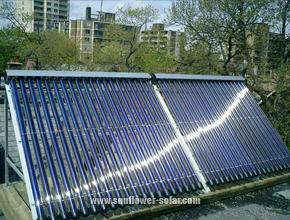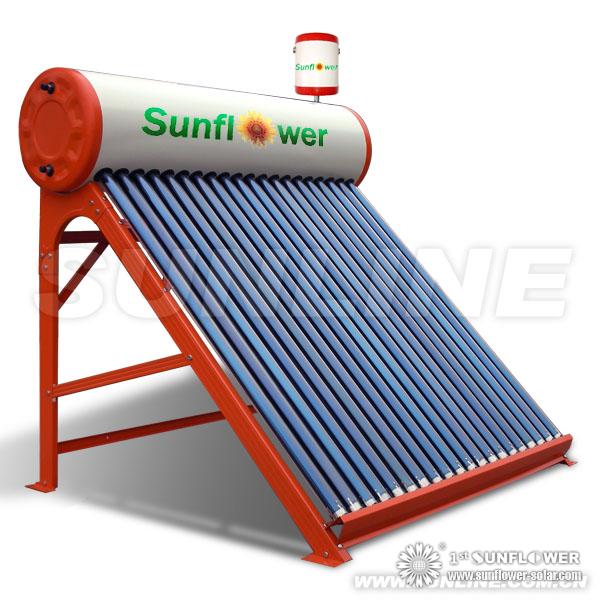Heat carrier fluids for solar water heating systems
Author:None
From:None
Post time:03/31/2012
View:5747
Heat carrier fluids carry heat through a heat exchanger in the heat in solar water heaters and solar panels.
Heat carrier fluids carry heat through a heat exchanger in the heat in solar water heaters and solar panels. When choosing a heat carrier fluid, you and your solar system contractor should the following criteria:

Coefficient of expansion - the relative change in length (or sometimes in volume, if specified) of a material for a unit of temperature change
Viscosity - resistance of a liquid to shear forces (and thus to flow)
Thermal power - the ability of matter to store heat
Freezing point - the temperature below which a liquid turns fixed itself in a
Boiling point - the temperature at which a liquid boils
Flash point - the lowest temperature of the vapor of a liquid air can be ignited.
For example, in a cold climate, solar water heaters need liquids with low freezing points. Liquids are exposed to high temperatures, such as in a desert climate, should a high boiling point. Viscosity and heat capacity required to calculate the amount of pumping energy. A fluid with low viscosity and high specific heat is easier to pump because it is less resistant against electricity and transfers more heat. Other properties, the determination of the effectiveness of a fluid to help their corrosiveness and stability.
Types of Heat-Transfer Fluids
The following are some of the most commonly used heat-transfer fluids and their properties. Consult a solar heating professional or the local authority having jurisdiction to determine the requirements for heat transfer fluid in solar water heating systems in your area.
Air
Air will not freeze or boil, and is non-corrosive. However, it has a very low heat capacity, and tends to leak out of collectors, ducts, and dampers.
Water
Water is non-toxic and inexpensive. With a high specific heat and a very low viscosity, it is easy to pump. Unfortunately, water has a relatively low boiling point and a high freezing point. It can be also corrosive if the pH (acidity / alkalinity level) not in a neutral level. Water with a high content of minerals (i.e. "hard" water) can form mineral deposits in collector tubes and piping system.
Glycol/water mixtures
Glycol/water mixtures have a 50/50 or 60/40 glycol-to-water ratio. Ethylene and propylene glycol are "antifreezes."
Hydrocarbon oils
Hydrocarbon oils a higher viscosity and lower specific heat than water. You need to pump more energy. These oils are relatively inexpensive and have a low freezing point. The basic groups of hydrocarbon oils are synthetic hydrocarbons, paraffin hydrocarbons, and aromatic mineral oils. Synthetic hydrocarbons are relatively nontoxic and require little maintenance. Paraffin hydrocarbons have a wider temperature range between freezer and boiling point than water, but they are toxic and require a double-walled, closed-loop heat exchanger. Aromatic oils are the least viscous hydrocarbon oils.
Refrigerants/phase change fluids
These are commonly used as the heat transfer fluid in refrigerators, air conditioners, and heat pumps. They generally have a low boiling point and a high Wärmekapazität. Dies ermöglicht eine kleine Menge des Kühlmittels, um eine große Menge an Wärme sehr effizient zu übertragen. Kältemittel schnell auf Solarwärme, so dass sie effektiver an bewölkten Tagen als andere Transfer Flüssigkeiten. Wärmeaufnahme tritt auf, wenn das Kühlmittel siedet (Veränderungen Phase von flüssig zu gasförmig) in der Solarkollektor. Lösen des gesammelten Wärme erfolgt, wenn die nun gasförmige Kältemittel kondensiert, um eine Flüssigkeit wieder in einen Wärmeaustauscher oder Kondensator.
They generally have a low boiling point and a high Wärmekapazität. Dies ermöglicht eine kleine Menge des Kühlmittels, um eine große Menge an Wärme sehr effizient zu übertragen. Kältemittel schnell auf Solarwärme, so dass sie effektiver an bewölkten Tagen als andere Transfer Flüssigkeiten. Wärmeaufnahme tritt auf, wenn das Kühlmittel siedet (Veränderungen Phase von flüssig zu gasförmig) in der Solarkollektor. Lösen des gesammelten Wärme erfolgt, wenn die nun gasförmige Kältemittel kondensiert, um eine Flüssigkeit wieder in einen Wärmeaustauscher oder Kondensator.
Seit Jahren Fluorchlorkohlenwasserstoffe (FCKW) als Kältemittel, wie Freon, waren die primären Flüssigkeiten durch Kühlschrank, Klimaanlage und Wärmepumpe Herstellern verwendet, weil sie nicht brennbar, geringe Toxizität, stabil, korrosionsbeständig, und sind nicht einfrieren. Aufgrund der negative Effekt, dass FCKW auf die Ozonschicht haben, FCKW-Produktion läuft aus, da ist die Produktion von Fluorchlorkohlenwasserstoffen (FCKW). Die wenigen Unternehmen, die Kältemittel-geladenen Solaranlagen produziert haben entweder gestoppt Herstellung der Systeme ganz oder werden derzeit nach alternativen Kältemitteln. Einige Unternehmen haben Methylalkohol als Ersatz für Kältemittel untersucht.
Wenn Sie derzeit ein Kältemittel aufgeladenen Solaranlage und gewartet werden muss, sollten Sie sich an Ihren lokalen Solar-oder Kälte-Service professionell. Seit dem 1. Juli 1992 ist beabsichtigt Entlüftung von FCKW und HFCKW bei Service und Wartung oder Entsorgung der Geräte, die diese Verbindungen unzulässig und strafbar durch steife Geldstrafen. Obwohl die Produktion von FCKW nicht mehr in den USA 1996, kann ein lizenzierter Kältetechniker noch warten Ihr System. Vielleicht möchten Sie Ihren Kundendienst wenden, um den möglichen Ersatz des FCKW-Kältemittel mit Methylalkohol oder einem anderen Wärmeträger zu diskutieren.
Ammoniak kann auch als Kühlmittel verwendet werden. Es ist allgemein in industriellen Anwendungen eingesetzt. Aus Sicherheitsgründen Überlegungen ist es nicht in Wohngebieten eingesetzt. Die Kältemittel können wässrige Ammoniak oder ein Ammoniak-Gemisch Calciumchlorid sein.
Silicones
Silicones have a very low freezing point, and a very high boiling point. They are corrosion-resistant and durable. Since silicones have a high viscosity and low heat capacity, they need more energy to pump. Silicones also leak light, even through microscopic holes in a solar loop.
They generally have a low boiling point and a high Wärmekapazität. Dies ermöglicht eine kleine Menge des Kühlmittels, um eine große Menge an Wärme sehr effizient zu übertragen. Kältemittel schnell auf Solarwärme, so dass sie effektiver an bewölkten Tagen als andere Transfer Flüssigkeiten. Wärmeaufnahme tritt auf, wenn das Kühlmittel siedet (Veränderungen Phase von flüssig zu gasförmig) in der Solarkollektor. Lösen des gesammelten Wärme erfolgt, wenn die nun gasförmige Kältemittel kondensiert, um eine Flüssigkeit wieder in einen Wärmeaustauscher oder Kondensator.